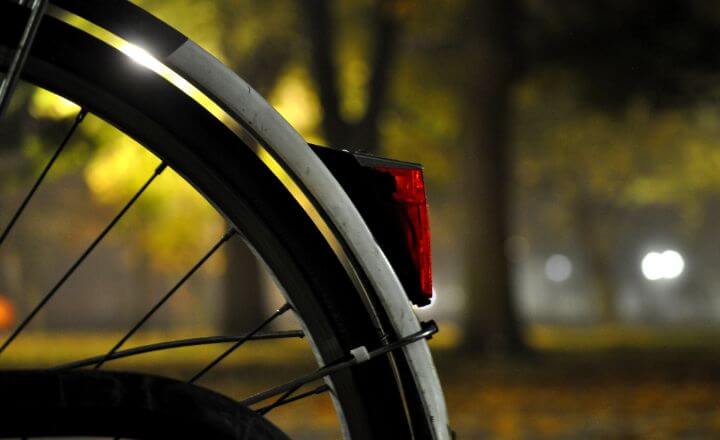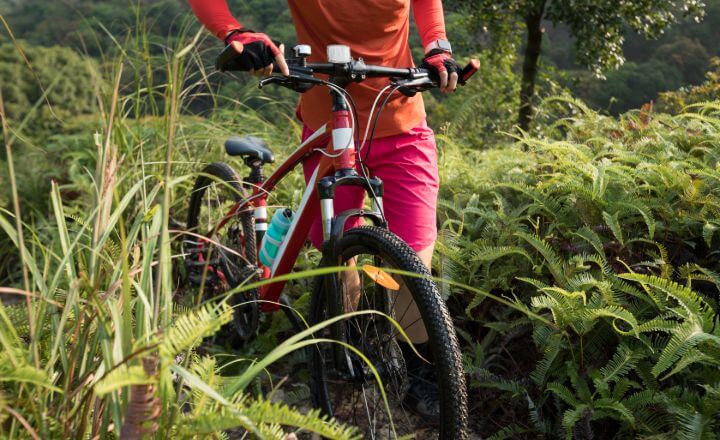(Last updated on February 1st, 2023)
As the only part of your bike that makes contact with the ground, tires are critical for a safe and fun ride. Whether you need to replace worn-out rubber or are looking to upgrade your tires, I’ve provided a comprehensive guide that’ll help you make the right decision. Choosing the right tire is far from rocket science, but these helpful tips and tricks will ensure you get the most out of your two-wheeler no matter where you ride.

How to Know It’s Time for New Bike Tires
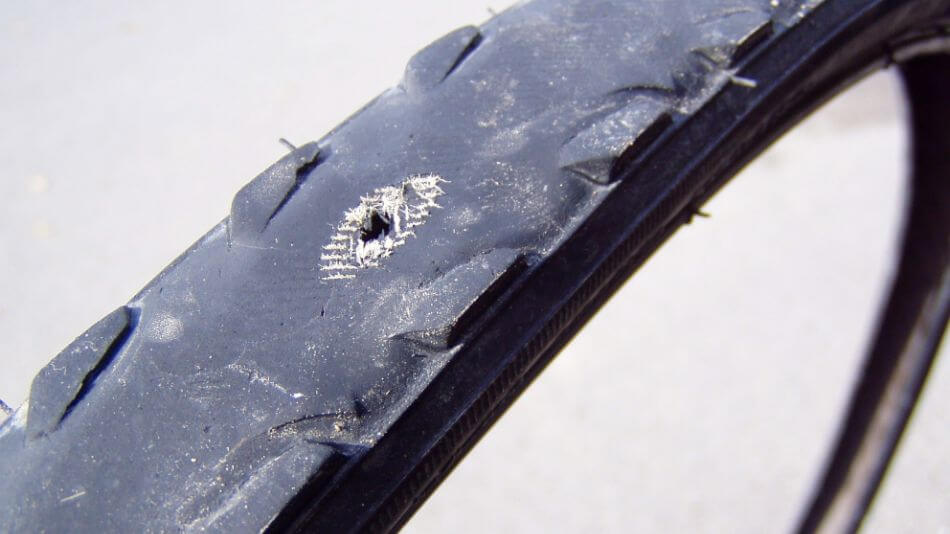
Replacing tires is one of the most common types of bike maintenance and it’s important to know when it’s time for some new rubber. Waiting too long to make the swap can lead to unexpected punctures or blowouts since the rubber layer around the inner tube is worn down. Stay ahead of your bike’s tire health and ride safer thanks to grippy rubber that’s in good shape.
Here are some common signs that it’s time to buy new bike tires:
- Tire tread is “bald” or overly smooth with little traction
- The inner thread (hashtags) are visible on the tire sidewall
- There is a large gash or skid mark
- Recent increase in flat tires caused by worn tread
- Cracking or brittle rubber that flakes off the sidewalls (old tires)
- Any odd bulges in the tire
- Decrease in bike handling
How to Get the Right Bike Tire Size

Getting the right tire size for your bike isn’t very difficult, but there are a few tips to help you select the appropriate tire dimensions. We’ll break down the key measurements when it comes to bike tires and where to find them.
Tip 1: The sidewall is your friend. Check the tire sidewall for numbers that indicate both the tire width and wheel diameter. These measurements will either be brightly painted on or embossed into the rubber, which can be a little harder to make out.
Tip 2: Deciphering ISO numbers. If you see something like “25-622” or “60-584” these are measurements from the International Standardization Organization (ISO). The first number refers to the tire width in millimeters and the second number states the inner tire diameter which matches up to wheel size. This can be a confusing number, so only pay attention to it if there aren’t any other size markings.
Tip 3: There are common tire sizes you’ll come across. Mountain bike tire widths vary between 1.5” to 4” and come in either 26”, 27.5”, or 29” wheel diameters. All road tires are 700c and have a width that ranges from 23mm to 40mm+.
Types of Bike Tires
Tires come in all shapes and styles to match the type of terrain riders will encounter. As the only part of the bike that actually makes contact with the ground, tires are specifically designed to perform well in certain conditions, whether that’s smooth pavement or loose dirt. Keep reading to learn more about the main bike tire categories.
Road Bike Tires
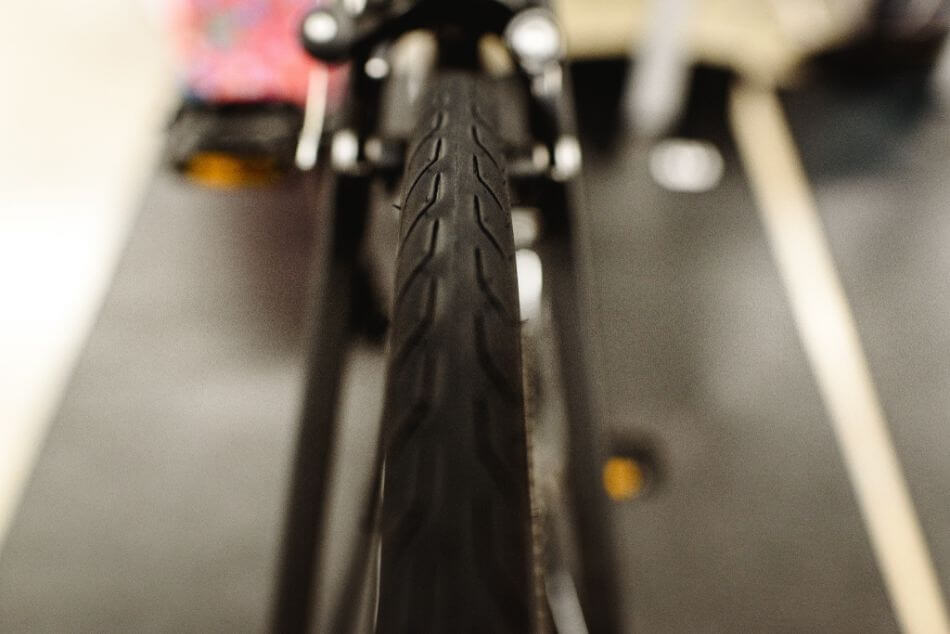
Road bike tires are skinny tires designed to roll as fast as possible over pavement. The most efficient construction is a slick tire with a shallow tread pattern that glides over the smooth surface. The slim profile cuts through the air effectively, but there is a trend towards wider road tires (around 28mm) that have lower rolling resistance than traditional 23mm or 25mm sizes.
Some road tires have light treads that can channel water in wet conditions or provide some extra grip while cornering. Standard road bike tires range between 23mm to 30mm wide, 700C diameter, and can be inflated to well over 100 psi.
Urban/Commuter Bike Tires
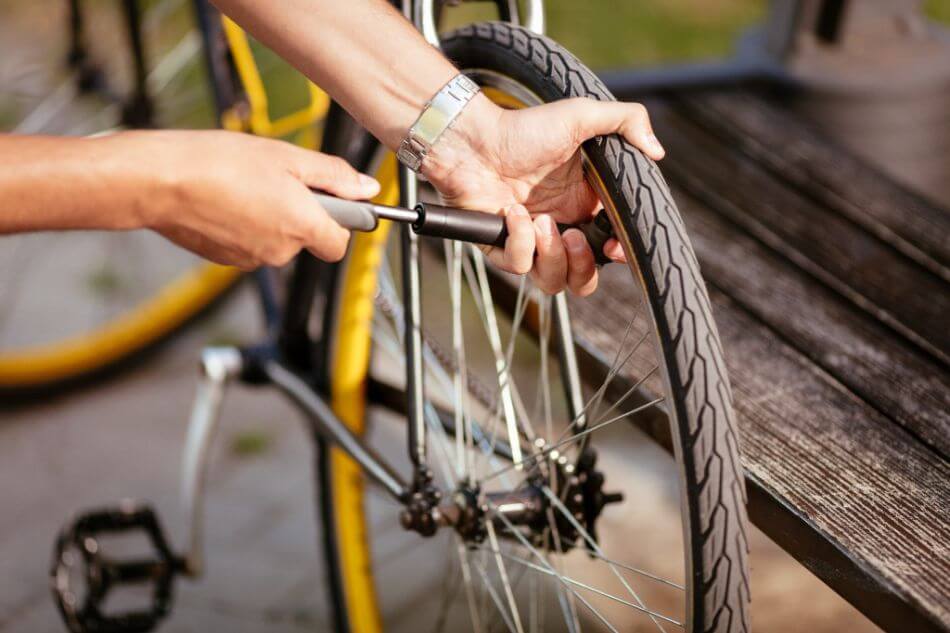
This kind of hybrid tire performs well in the city and is more comfortable and grippy than road tires while sacrificing pure speed. Urban tires are typically 700C diameter as well, but are much wider than road tires, often between 35mm to 45mm. There are deeper tread patterns and the larger air volume means the tires will absorb bumps better and silence road buzz.
Gravel and Cyclocross Tires
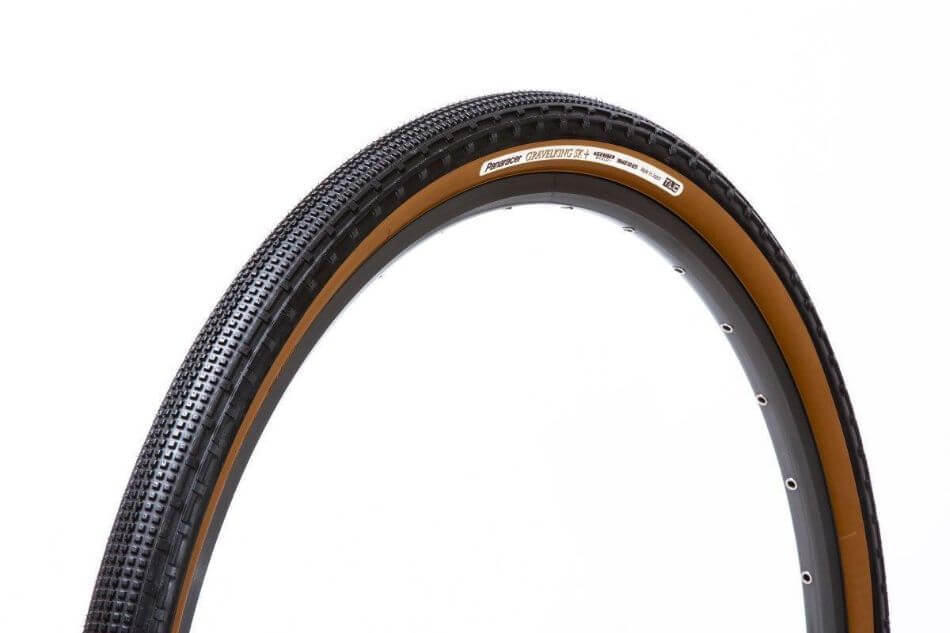
While gravel tires are also 700C in diameter, they have a wider profile and heavier tread pattern than other road tires. Gravel tires typically measure between 35mm to 45mm in width. Cyclocross racing has similar demands as gravel riding in which riders need more traction than what’s provided by slick road tires. Gravel and cyclocross tires aren’t exactly interchangeable, but it’s more a matter of personal preference and route conditions.
I especially enjoy this tire category because of the variety of tread designs that allow riders to match rubber to their riding style, ranging from light gravel to loose dirt or forest mud. Small knobs, deeper water channels, and grippier tire shoulders are common features.
Mountain Bike Tires
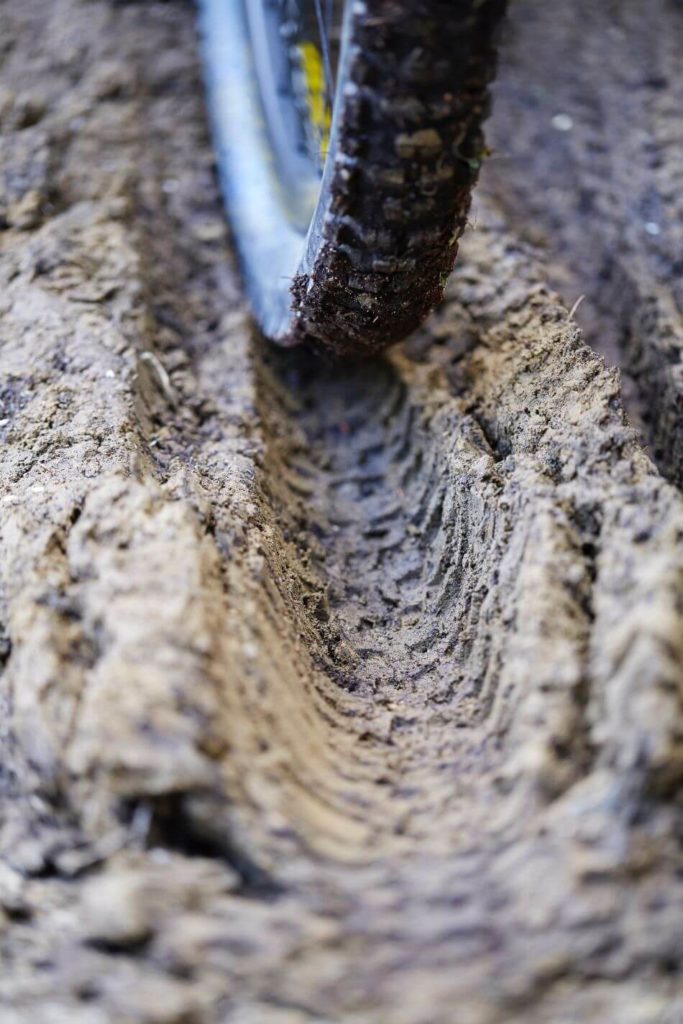
The knobbiest of the bunch, mountain bike tires feature a heavy tread pattern and wide profile to increase traction while riding off-road. While road tires are all 700c, MTB rubber are available in 26”, 27.5”, and 29” diameters. Riders can also choose between tire widths between 1.9” up to 3”. Tires that measure over 3” are considered fat bike tires.
Fat Bike Tires
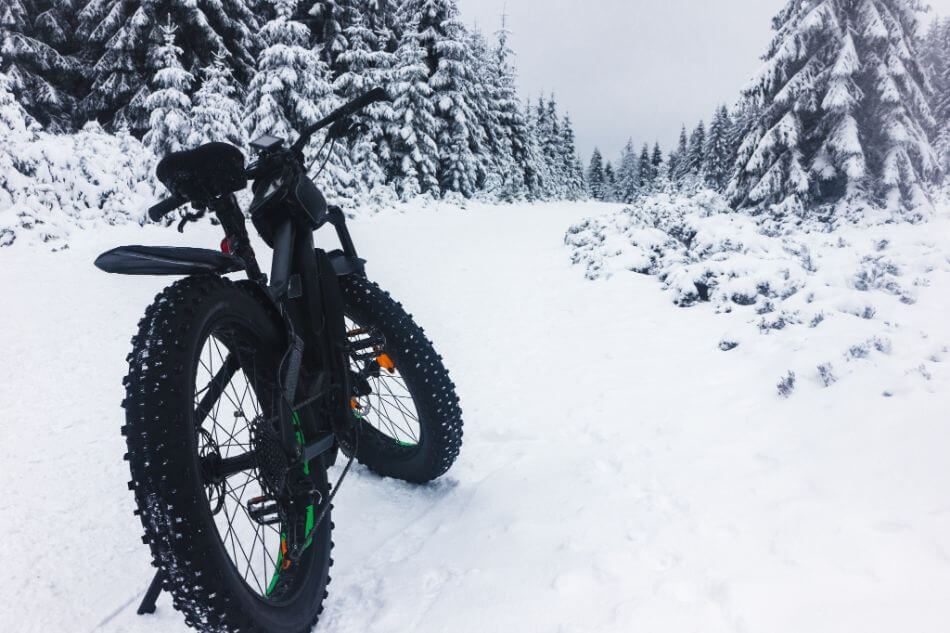
When I first saw fat tires, I couldn’t believe they were designed for bicycles— these tires are massive. Fat biking has swelled in popularity as riders enjoy the extra capabilities that oversized wheels and tires have on slippery terrain like snow, sand, or mud. Fat tires typically measure more than 3” wide and are installed on specialized 26” rims.
You May Also Like:
Compare Bike Tire Categories at a Glance
| Road Bike Tires | Urban/Commuter Tires | Gravel/Cyclocross Tires | Mountain Bike Tires | Fat Tires | |
| Width | 23-35mm | 28-45mm | 30-45mm | 2.0”-3” | 4” |
| Wheel size | 700c | 700c | 700c, 650b/27.5” | 26”, 27.5”, 29” | 26” |
| Tread | Slick | Semi-slick | Small knobs | Very knobby | Knobby |
Other Bike Tire Options
Tubeless Tires
Nowadays, tubeless is becoming the go-to tire option for mountain bikers or high-mileage riders. Tubeless tires are designed to form a perfect seal with the wheel rim so the tire itself can hold air rather than using an inner tube. The tube is replaced with some liquid sealant inside the tire that automatically patches up the tire in case something pokes through the rubber.
The self-sealing properties of tubeless tires make them very popular among MTB riders that frequently get flats, and as they get lighter, they are becoming more popular among roadies, too. Keep in mind that you need rims that are compatible with tubeless tires.
Puncture-Resistant Bike Tires
Other tires utilize specialized rubber compounds or extra layers to prevent flats. These tires are usually heavier and may roll a bit slower, but earn their keep by preventing thorns, glass, and other debris from getting through to the inner tube.
Studded Tires
Studded tires have small metal spikes distributed throughout the tread pattern that dig into snow or ice. This extreme tire type is not very common but can make a big difference if you typically ride around icy paths or on hard-packed snow in the winter.
If there are patches of bare pavement, however, the metal spikes will damage the asphalt and dull too fast— you’re better off with fat tires or a heavy MTB tire if you ride mixed terrain in the colder months.
What is Thread Count Casing (TPI)?
TPI means “threads per inch” and refers to the density of fibers that make up the tire. This metric works similarly to the thread count on your bedsheets— a higher count means a more flexible, supple feel. Bike tires are made of rubber as well as a web of nylon or aramid fibers. As tires wear away, sometimes the threads are revealed and you can see them. It’s an important aspect that’s often overlooked when selecting new tires.
Low TPI casings are cheaper to produce and have thicker threads. High TPI tires are lighter and respond better to the riding surface with a more supple feel, as well as additional puncture resistance. TPI is typically reflected in the price of the tire, but it’s worth taking a look into the specifics to see the actual number. Tires range from 22tpi up to 120tpi for premium tires.
What to Do with Old Bike Tires?
Residential waste services aren’t equipped to handle tires, but most local bike shops and retailers will accept your old rubber and pass them on to the appropriate recycling programs. This way you can easily get rid of extra bike parts and the old tires can be processed as environmentally friendly as possible.
Buyer Guide: How to Choose the Right Tire
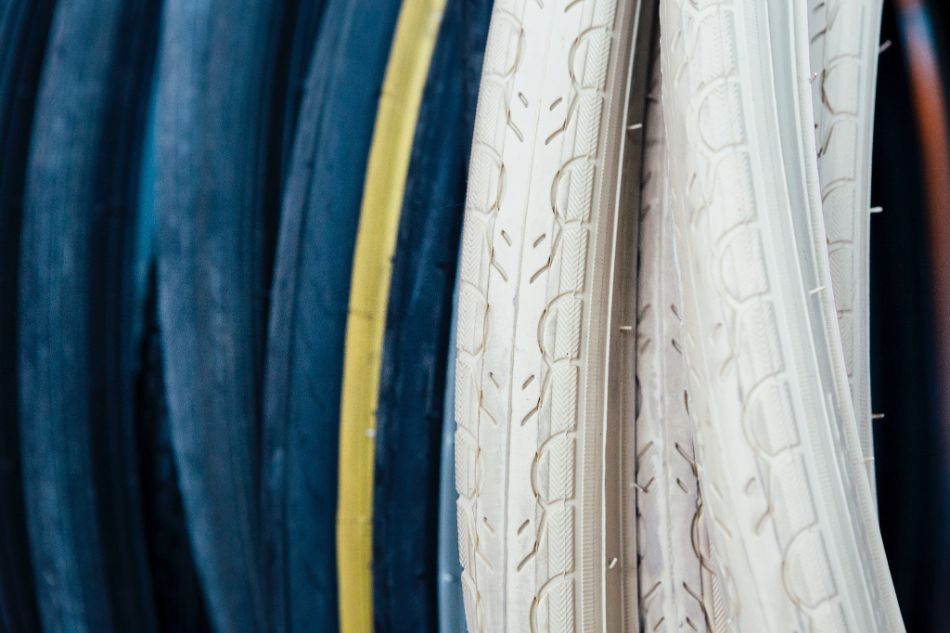
There is almost an endless variety of bike tires out there and their relatively homogenous look can make selecting the correct tire a chore. Below, I break down the steps to choosing the right tire that will fit your bike and match your specific riding style. You can use these tips to purchase tires in-store as well as confidently pick out your desired rubber online.
Wheel Size
First things first— the new tire has to fit the rim diameter. Mountain bikes have 27.5” or 29” (26” for older models) and all hybrids and road bikes use 700C-sized tires. Take a look at the sidewalls of your old tires to confirm the wheel diameter you need.
Tire Width
That sidewall label also states the tire width of your current tire. Now’s the time to decide if you want the same tire width again or change to a different width. There’s a limit to the width a specific rim can handle, but there is typically a +/- tolerance of several millimeters. Narrower tires roll a bit faster but have less traction whereas larger tires offer more grip and can run at lower pressures.
Tread Pattern
Once you know the appropriate diameter and width, you can browse the tread patterns available. Choose a slick tread if you normally stick to paved surfaces. Heavier tread with water channels works well on mixed surfaces and varied weather conditions. Tires with many small knobs perform great on gravel paths and hard-packed dirt, but if you ride mountain bikes, you’ll need wide tires with large knobs.
Should I Choose Name Brands?
Normally, I root for the underdog, but when it comes to bike tires, I recommend sticking to the major tire brands. They understand what makes a good tire and have a wide range of options for any budget, plus you’ll know what to expect in terms of quality. Some unbranded tires or unknown companies make cheap tires that are made of compounds that won’t stand up to daily use.
Price and Extra Features
With bicycle tires, you typically get what you pay for. The technology has been around for a long time so, while there are plenty of choices, there aren’t many earth-shattering new ideas. I recommend investing in a mid-level tire or higher that will last much longer than budget tires with low TPI counts and less grippy rubber.
Additional capabilities like puncture protection, studs, or colors will cost you a bit more but can be a smart investment. Ideally, tires last a long time and are fairly maintenance-free, so if you are getting lots of flats or find yourself losing grip, it may be time to upgrade to a better set.
Frequently Asked Questions
A 700x25c tire is a narrow road tire that is 25mm wide. If you see a “700” or “c” marking, that means it’s a road tire, which typically range from 23mm to 32mm in width.
As the only part of the bike that actually makes contact with the ground, bike tires are crucial to performance and safety. Riding on inappropriate tires can lead to a lack of traction and losing control in technical or wet conditions. The right tire for you balances grip, speed, and comfort.
Yes, but to a limit. The old rule of thumb in road biking used to be that narrower tires are faster and more aerodynamic, but new studies have shown that slightly wider-profile rubber can lower rolling resistance. Larger tires also provide increased comfort, traction, and puncture-proof characteristics.
Nowadays, the “C” refers to road bike wheel size. The 700C denomination originated as a standard rim size in which the “c” was a specific beat seat diameter matched to a 700-millimeter outer tire diameter. Modern road wheels and tires have all agreed on this standard, but the “c” still sticks around.
The idea that skinnier road tires are faster has proved to be a myth. 28mm tires have lower rolling resistance and provide a bit more cushion than traditional 23mm or 25mm rubber for 700c wheels.

Jeffrey Brown is a writer, editor, and professional bike mechanic with over 7 years of experience working in full-service and community-based bike shops. As a bicycle educator, he has supported youth programs across the US that teach bike mechanics and life skills to prepare the next generation of cyclists.
Jeffrey began his professional mechanic career at his university bike co-op, so he recognizes the grassroots power of the cycling community. Initially self-trained as a mechanic, his subsequent positions as manager and lead educator gave him official training. He has won various awards and grants for his role as a bicycle and environmental advocate.

